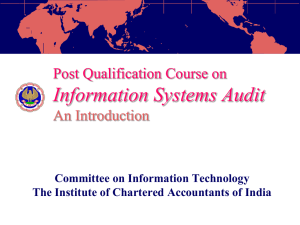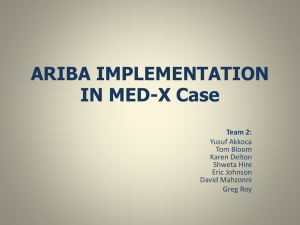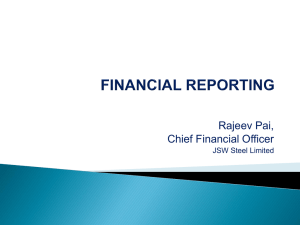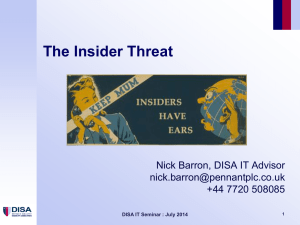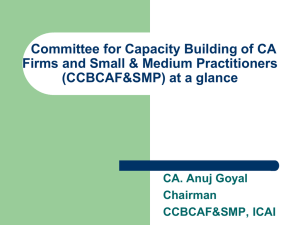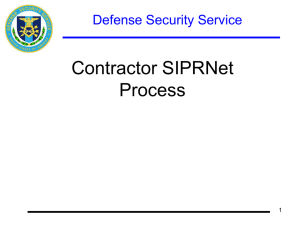DISA Module 5 by CA.Shweta Ajmera - Indore
advertisement
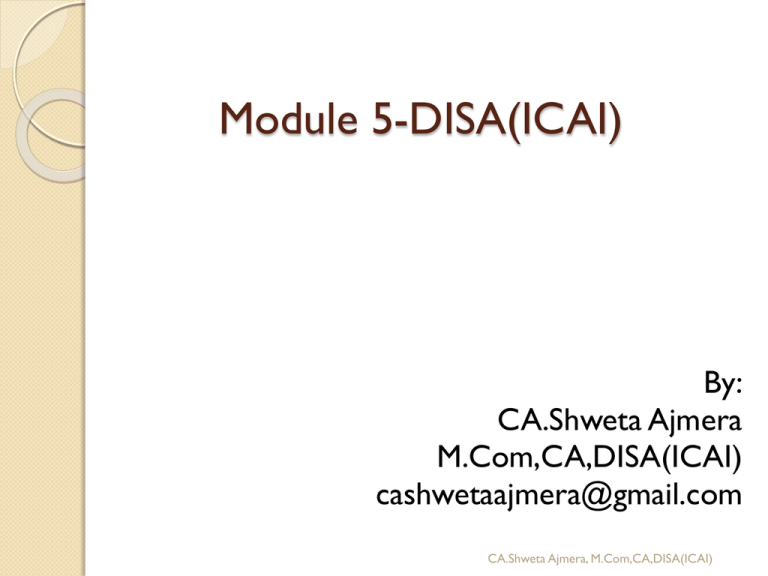
Module 5-DISA(ICAI) By: CA.Shweta Ajmera M.Com,CA,DISA(ICAI) cashwetaajmera@gmail.com CA.Shweta Ajmera, M.Com,CA,DISA(ICAI) MODULE 5 INFORMATION SYSTEMS ORGANIZATION & MANAGMENT CA.Shweta Ajmera, M.Com,CA,DISA(ICAI) CA.Shweta Ajmera, M.Com,CA,DISA(ICAI) Information System Organisation & Management What is Information? What is System? What is Organisation? What is management? CA.Shweta Ajmera, M.Com,CA,DISA(ICAI) Coverage – Module 5 This module covers 8 % of the DISA syllabus i.e.approximately 16 questions. It has been divided as follows: Chapter 1 - Governance Chapter 2 - The IS Management Process Chapter 3 – Auditing Information Systems Organisation & Management CA.Shweta Ajmera, M.Com,CA,DISA(ICAI) Unit-1 Governance CA.Shweta Ajmera, M.Com,CA,DISA(ICAI) LEARNING GOAL To understand as an auditor, structure of an IS Organization and Management with respect to various aspects of planning, policies, standards, procedures and strategies. CA.Shweta Ajmera, M.Com,CA,DISA(ICAI) Meaning What is Governance? --- To Govern??? --- To control??? Who will be the authority to govern any organisation??? Any example??? CA.Shweta Ajmera, M.Com,CA,DISA(ICAI) GOVERNANCE • Enterprise Governance • Corporate Governance • IT Governance • E- Governance CA.Shweta Ajmera, M.Com,CA,DISA(ICAI) ENTERPRISE GOVERNANCE Definition: • The Set of responsibilities and Practices exercised by the Board and executive management with the goal of : providing strategic direction ensuring that objectives are achieved ascertaining that risks are managed appropriately verifying that the organization's resources are used responsibly CA.Shweta Ajmera, M.Com,CA,DISA(ICAI) ENTERPRISE GOVERNANCE ENTERPRISE GOVERNANCE CORPORATE GOVERNANCE i.e. Conformance – Accountability & Assurance (external, historical view) BUSINESS GOVERNANCE i.e. Performance – Value Creation & Resource Utilisation (internal, futuristic view ) CA.Shweta Ajmera, M.Com,CA,DISA(ICAI) ENTERPRISE GOVERNANCE Corporate Governance : Conformance of processes – state or act of adherence to certain specification, standard or guideline • CA.Shweta Ajmera, M.Com,CA,DISA(ICAI) Conformance Conformance deals with external processes like: • • • • • • • Board committees - audits, remuneration and nominations Compliance with regulations Roles of the chairman and CEO Board of directors – composition, training, nonexecutive directors etc Internal Controls Risk Management Executive remuneration CA.Shweta Ajmera, M.Com,CA,DISA(ICAI) Business Governance : Performance •- Value creation and Resource Utilization. Helping Board of Directors to : Make strategic decisions Understand its appetite for risk Identify its key points of decision making CA.Shweta Ajmera, M.Com,CA,DISA(ICAI) Corporate Governance i.e. Conformance Business Governance i.e. Performance CA.Shweta Ajmera, M.Com,CA,DISA(ICAI) CORPORATE GOVERNANCE Ethical corporate behaviour by directors or others charged with governance in the creation and presentation of wealth for all stakeholders. CA.Shweta Ajmera, M.Com,CA,DISA(ICAI) Corporate Governance OECD says: The distribution of rights and responsibilities among different participants in the corporation, such as board, managers, shareholders and other stakeholders and spells out rules and procedures for making decisions on corporate affairs. By doing this, it also provides the structure through which the company objectives are set and means of attaining those objectives and monitoring performance. CA.Shweta Ajmera, M.Com,CA,DISA(ICAI) Corporate Governance Implications – Includes system for: 1. 2. 3. 4. 5. 6. Managing and monitoring risks and Companies must have an internal control system, to (a) manage systems and (b) culture Provide continued value addition to shareholders & stakeholders Maintain ethical corporate behavior – integrity, openness, transparency, accountability Implementation – dependent on right people, making right decisions, at right time Other – board committees, compliance, role of CEO etc, board dynamics, & executive remuneration CA.Shweta Ajmera, M.Com,CA,DISA(ICAI) Decision making style Info. systems Funct. strategies & policies Goals Culture & Values Compet. advant. Org. structure HR mant. Mant. of systems CA.Shweta Ajmera, M.Com,CA,DISA(ICAI) Corporate Governance issues determined success & failure 1. 2. 3. 4. that Culture, ethics and tone at the top The role of the chief executive officer The board of directors The board of directors Failures Enron,Worldcom, Parmalat, Xerox Successes Tesco,Bangkok Mass Transit Systemand Southwest Airlines CA.Shweta Ajmera, M.Com,CA,DISA(ICAI) Strategic Issues Underlying Success & Failures 1. 2. 3. 4. Choice and clarity of Strategy Effective strategy execution. Ability to respond to abrupt changes and fast moving market conditions. Ability to undertake successful mergers and acquisitions CA.Shweta Ajmera, M.Com,CA,DISA(ICAI) CA.Shweta Ajmera, M.Com,CA,DISA(ICAI) Traditional Role of IT • • Managing systems and project development Managing computer operations and the data centre • Training, staffing and developing IS skills • Providing technical services CA.Shweta Ajmera, M.Com,CA,DISA(ICAI) New Role of IT (incorporating Traditional Role) Initiation and design of strategic information systems Infrastructure planning, acquisition, control and implementing improvements Linking the business with the Internet and e-commerce processes Systems Integration Educating non technical staff about IT and technical staff about the business Support for end user computing through help desks etc Constant liaison with top management Business process reengineering Managing related outsourced function CA.Shweta Ajmera, M.Com,CA,DISA(ICAI) INFORMATION TECHNOLOGY GOVERNANCE IT governance ensures that enterprise’s IT sustains and extends the organization’s strategies and objectives. IT governance is a sub-set of corporate governance Ensures twin purposes: IT delivers value to the business, by aligning IT with the objectives of the Organization. IT risks are reduced by embedding accountability into the processes of the enterprise. CA.Shweta Ajmera, M.Com,CA,DISA(ICAI) IT Governance- Purpose IT delivers value to the business, by aligning IT with the objectives of the organisation, and IT risks are reduced by embedding accountability into the processes of the enterprise Dependant on availability of : The right information to the Right persons At the right time At the right place most effectively and efficiently CA.Shweta Ajmera, M.Com,CA,DISA(ICAI) IT Governance-Some benefits By ensuring that IT resources are used optimally and responsibly, it helps to decrease costs and therefore promote efficiency By optimising resources for automation it ensures effective use of resources Helps the business to avail better opportunities and maximise benefits by aligning IT and business objectives Promotes the management of risks by providing for adequate security, compliance and reliability of information. CA.Shweta Ajmera, M.Com,CA,DISA(ICAI) Who needs IT governance ? Those enterprises where: Good corporate governance is lacking There is insufficient liaison between the board and the IT department IT is not a regular item on the board meetings agenda There are no well defined rules and procedures People are not clear about what IT is doing CA.Shweta Ajmera, M.Com,CA,DISA(ICAI) Who needs IT governance ? There are many IT mishaps There are many IT issues pending resolution for a long time The IT skills are decreasing There are frequent network problems There is no planning for contingencies , etc CA.Shweta Ajmera, M.Com,CA,DISA(ICAI) INFORMATION TECHNOLOGY GOVERNANCE Best Practices in IT Governance : IT / IS Assurance System – recommended best practices and providing assurance on their compliance. IT Strategy Committee – differs from IT steering committee and works as advisory to Board. The Balance Scorecard Information security governance – CIA issues etc Enterprise architecture – Zachmann model used to map it assets to promote management, planning and understand IT investments from technology and business perspectives and align them with organisational goals. Risk management – assessment & treatment CA.Shweta Ajmera, M.Com,CA,DISA(ICAI) IT STRATEGY COMMITTEE Its scope includes not only advice on strategy when assisting the board in its IT governance responsibilities but also to focus on IT value, risks and performance. This is a mechanism for incorporating IT governance into enterprise governance. As a committee of the board, it assists the board in overseeing the enterprise’s IT-related matters by ensuring that the board has the internal and external information it requires for effective IT governance decision making. CA.Shweta Ajmera, M.Com,CA,DISA(ICAI) IT BALANCE SCORECARD The standard IT balance scorecard is a process management evaluation technique that can be applied to the IT business governance process in assessing IT functions and processes. The method goes beyond the traditional financial evaluation, supplementing it with measures concerning customer ( user ) satisfaction, internal processes and ability to innovate. These additional measures drive organization toward optimum use of IT, which is aligned with organization’s strategic goals. CA.Shweta Ajmera, M.Com,CA,DISA(ICAI) CA.Shweta Ajmera, M.Com,CA,DISA(ICAI) CA.Shweta Ajmera, M.Com,CA,DISA(ICAI) INFORMATION SECURITY GOVERNANCE Information security governance is a sub-set of corporate governance that provides strategic direction for the security activities and ensures objectives are achieved. It ensures that information security risks are appropriately managed and enterprise information resources are used responsibly. CA.Shweta Ajmera, M.Com,CA,DISA(ICAI) ENTERPRISE ARCHITECTURE EA involves documenting an organization’s IT assets in a structured manner to facilitate, understanding, management and planning for IT investments. An EA often involves both a current and optimized state representation. The current focus on EA is a response to the increasing complexity of modern organizations, and an enhanced focus on aligning IT with business strategy and ensuring IT investments deliver real returns. CA.Shweta Ajmera, M.Com,CA,DISA(ICAI) ENTERPRISE ARCHITECTURE CA.Shweta Ajmera, M.Com,CA,DISA(ICAI) E- GOVERNANCE Refers to the use of information technology in order to exchange information and services with citizens, businesses and other arms of the government. Government – to – Citizen Government – to – Customer Government – to – Business Government – to - Government CA.Shweta Ajmera, M.Com,CA,DISA(ICAI) Best Practices in Enterprise Governance : Strategic Oversight Enterprise Risk Management The acquisition process Board performance CA.Shweta Ajmera, M.Com,CA,DISA(ICAI) Strategic Oversight IT Strategy Committee Balance Score Card CIMA Strategic Score card CA.Shweta Ajmera, M.Com,CA,DISA(ICAI) IT Strategy Committee It is a preparatory committee. The Board is still responsible for taking Strategic Decision. This committee is responsible for taking major decisions. CA.Shweta Ajmera, M.Com,CA,DISA(ICAI) CIMA Strategic Scorecard CA.Shweta Ajmera, M.Com,CA,DISA(ICAI) Enterprise Risk Management This reconciles both the: Assurance that the business understands risks and is managing them actively i.e. conformance Need to better integrate risk management in Decision Making activities at all levels i.e. performance CA.Shweta Ajmera, M.Com,CA,DISA(ICAI) The acquisition Process Mergers & Acquisitions are increasing: The Critical success factors are: Effective and experienced full time project management Thorough evaluation of synergies and ruthless implementation Effective due deligence Use of experiences specialists in M & A Early identification of risks with appropriate risk reduction actions. CA.Shweta Ajmera, M.Com,CA,DISA(ICAI) Board Performance Performance Evaluation & Measurement centre Dynamics Design CA.Shweta Ajmera, M.Com,CA,DISA(ICAI) Chapter 1 Q n A 1. Which of the following statements is FALSE? (a) The CIMA scorecard deals with strategic position, options, implementation and risks only (b) The balanced scorecard also brings into focus non-financial performance indicators (c) The new role of the IT department also includes liaison with top management (d) Corporate governance is a system for managing risks only CA.Shweta Ajmera, M.Com,CA,DISA(ICAI) Chapter 1 Q n A 2. Which of the following statements is FALSE? (a) The balanced scorecard deals with financial and non-financial performance measurements (b) Information security need not consider issues like authenticity, reliability, accountability and non-repudiation (c) Risk treatment is an integral part of risk management (d) The Zachmann model involves documenting the organisations IT assets in order to align them with the strategic goals of the organisation CA.Shweta Ajmera, M.Com,CA,DISA(ICAI) Unit-2 The Information System Management Process CA.Shweta Ajmera, M.Com,CA,DISA(ICAI) Agenda To understand-managing IS PDCA cycle(Deming Cycle) PDCA-application to management processes Types of plans Steering Committee How to acquire the IS resources Control Methodologies Benchmarking Budgets and Variances etc CA.Shweta Ajmera, M.Com,CA,DISA(ICAI) Introduction Objectives of organisation Importance of management Importance of managing the IS department PDCA-main role Planning Long range plans Short range plans By steering committee Role of management CA.Shweta Ajmera, M.Com,CA,DISA(ICAI) Objectives of Organisation To survive-It does this by: Identifying and meeting the needs of customers & other stakeholders, in order to achieve competitive advantage in an effective and efficient manner To achieve maintain and improve its performance and capabilities Systematic process is required CA.Shweta Ajmera, M.Com,CA,DISA(ICAI) Importance of Management Management is an organ whose performance determines the performance and even the survival of the Institution. The importance of management Getting things done Determine goals based on needs Need to empower people with responsibility, authority and accountability CA.Shweta Ajmera, M.Com,CA,DISA(ICAI) What Management has to do? Determine goals on the basis of customer needs. Eg. Touchsreen mobile To implement and operate the required resources and processes. To monitor and review the process and resources. Maintain and improve the system Structure follows Strategy People power CA.Shweta Ajmera, M.Com,CA,DISA(ICAI) Importance of managing ISD It has an operational as well as a Strategic role to play in the success of organisation. E-commerce, E-Business, and other IT initiatives To manage ISD , we have to understand the IS management system properly CA.Shweta Ajmera, M.Com,CA,DISA(ICAI) Deming Cycle Conceived by Walter Shewhart in 1930’s Popularised by Dr.W.Edwards Deming (leader in Modern quality control) 4 step Problem Solving Process for quality management. In six sigma which is quality control system, this is known as DMAIC- Define, Measure, Analyse, Improve and Control. CA.Shweta Ajmera, M.Com,CA,DISA(ICAI) PDCA CA.Shweta Ajmera, M.Com,CA,DISA(ICAI) PDCA Examples ISO 9001- Requirement for quality management system ISO 27001- Required for Information security management system The Pearl River-Newyork CA.Shweta Ajmera, M.Com,CA,DISA(ICAI) The Planning function What should be done? How should it be done? When should it be done? Who should do it? A plan is an action statement CFS-Critical Success Factors CA.Shweta Ajmera, M.Com,CA,DISA(ICAI) Planning Long Range Plans Short Range Plans This plans are the responsibility of Steering Committee. CA.Shweta Ajmera, M.Com,CA,DISA(ICAI) Steering Committee Appointment by-Board of directorsExecutive level Responsibilities-Charter –Approved by Board Objective-IS department is aligned with the organisation mission and objectives Chairman- Chaired by member of BOD who understands information technology risks and issues Representation CA.Shweta Ajmera, M.Com,CA,DISA(ICAI) Functions of Steering Committee Board for large IS Projects only Review and Approve long range and short range plans only Establish size and scope of IS function and set principles Review and approve major acquisition of the IS source within limits Approve and monitor the progress of major project Liase between IS and the user department CA.Shweta Ajmera, M.Com,CA,DISA(ICAI) Advantages of Steering Committee Top Management Involvement User representation Centralisation of Authority Promotes user ownership and systems Promotes Planning and Control Establishes user focus on IS CA.Shweta Ajmera, M.Com,CA,DISA(ICAI) CA.Shweta Ajmera, M.Com,CA,DISA(ICAI) Planning Master Plan of the organisation- Main plan prepared by BOD to guide the organisation towards its objectives. It includes:: A statement of mission, vision and values A statement determining strategic objectives The strategies for achieving those objectives The factors that may favourably and adversely affect the achievements of those objectives Master plan is an aid for Long range and short range plans CA.Shweta Ajmera, M.Com,CA,DISA(ICAI) Long Range Plans Dimensions of Long range plans ----- Long Range----- Strategic Plans Stratergy is derived from Greek word “ strategia”i.e art or science of being an Army General which required them to lead an army. CA.Shweta Ajmera, M.Com,CA,DISA(ICAI) Strategic Plans 3 Dimensions Time- 2 to 5 years Projects- clearly defined and to be completed in time Goals- Link between goals of organisation and projects are clearly defines CA.Shweta Ajmera, M.Com,CA,DISA(ICAI) Inputs for effective and efficient planning Stratergy and defined organisation goals Needs of customers and stakeholders Statutory, Regulatory and Contractual needs Evaluating performance data on product and processes Previous experiences any related risk assessment and treatment information CA.Shweta Ajmera, M.Com,CA,DISA(ICAI) Outputs of good Planning Defined product outcomes and support process Skills and knowledge required by people Responsibility, Authority and accountability of processes and improvement plans Resource needs Metrics for evaluating performances Need for improvement methods Need for Documentation and Records CA.Shweta Ajmera, M.Com,CA,DISA(ICAI) Contents of Long Range Plans Current IS assessments-what do we have, or where are we? Future IS assessments: Where do we want to be in next five years in order to meet our strategic objectives Development Strategy: Methodologies and Vision used to reach the stated Strategic Objectives CA.Shweta Ajmera, M.Com,CA,DISA(ICAI) Methods of creating LRP SWOT Eg. Dell It needs: 1. Team Building 2. Scenario Models 3. Concensus creating exercises CA.Shweta Ajmera, M.Com,CA,DISA(ICAI) Short Range Plans Operational or Tactical Plans They are derived at regular intervals from LRP Micro issues: Project Reports Resource Allocation Implementation Schedule Initiatives to be undertaken CA.Shweta Ajmera, M.Com,CA,DISA(ICAI) Why does Planning Process always fails?? Time Consuming Other immediate tasks Intensive mental effort Future look more uncertain CA.Shweta Ajmera, M.Com,CA,DISA(ICAI) CA.Shweta Ajmera, M.Com,CA,DISA(ICAI) POLICIES One of the function of the Steering Committee is to develop policies -- which are implemented through standards, Guidelines and Procedures for ISD. -- Internal controls will flow from creation of policies, which are required to ensure that the stated objectives are met CA.Shweta Ajmera, M.Com,CA,DISA(ICAI) What is Policy? Formal statement made by the management of their overall intention and direction A stated coarse of action with a defined purpose and scope in order to guide. CA.Shweta Ajmera, M.Com,CA,DISA(ICAI) Effective Policies Ideally in writing Clear, Concise, communicated in writing Under stood by all employees Regularly viewed and updated Be made by top management in order to ensure consistency CA.Shweta Ajmera, M.Com,CA,DISA(ICAI) IS -policies Use of internet and email Data Security Change management Outsourcing Data retention Human Resources Project Management etc CA.Shweta Ajmera, M.Com,CA,DISA(ICAI) STANDARDS They are documents which state management rules, legal and regulatory issues that are mandatory CA.Shweta Ajmera, M.Com,CA,DISA(ICAI) GUIDELINES To choose most appropriate practice CA.Shweta Ajmera, M.Com,CA,DISA(ICAI) Procedures Procedures are detailed documents that define in writing how to ensure or apply the policy “ How to do it” statements CA.Shweta Ajmera, M.Com,CA,DISA(ICAI) G O A L S Business goals based on customer & stakeholder needs Framework of management intent POLICIES STANDARDS GUIDELINES PROCEDURES Management rules, legal and regulatory issues, that are mandatory Framework for understanding the standards & the list of tools to do it How to apply the policies i.e. how to do it CA.Shweta Ajmera, M.Com,CA,DISA(ICAI) Leadership Energy Energise Edge Execute Eg: General Electric- Kack Welch was appointed as the chairman of GE in 1981. His immediate aim is to make GE the leader in every business in which it was competing CA.Shweta Ajmera, M.Com,CA,DISA(ICAI) Importance of Leadership Plan Lead Organise Control Innovation etc. CA.Shweta Ajmera, M.Com,CA,DISA(ICAI) CA.Shweta Ajmera, M.Com,CA,DISA(ICAI) IS Resources- Acquisition Applications Information IT infrastructure People CA.Shweta Ajmera, M.Com,CA,DISA(ICAI) Process Process for the acquisition and Development of IT hardware will cover process like Make or Buy Decisions Inhouse or Outsourced Acquisition and Development and so on CA.Shweta Ajmera, M.Com,CA,DISA(ICAI) Acquisition & Implementation of resources Policies lead to determination and acquisition of resources and processes Processes lead to procedures and work instructions which should be documented Procedures should be capable of a) Verification – confirmation that procedure is accurate and complete at a low level, e.g. have we built the right product in accordance with specifications. b) Validation – corroboration that procedure is right or wrong in that context at ahigher level against standards and rules, e.g. did we build the right product as per user requirements, and c) Approval. CA.Shweta Ajmera, M.Com,CA,DISA(ICAI) Framework of management intent derived from business goals Policies Set of interrelated processes Systems Set of inter-related activities which transform inputs into outputs Processes / Practices Procedures Detailed steps to perform an activity Documented processes which can be verified, validated & approved Work Instructions CA.Shweta Ajmera, M.Com,CA,DISA(ICAI) Implementation of Processes What are Benchmarks? How much should we spend on ID department? Are we getting value from IS department? What are the goals of Benchmarking? -- Ultimate goal is to implement the Best Practices Where are Benchmarking Statistics Obtained from? CA.Shweta Ajmera, M.Com,CA,DISA(ICAI) Implementation - Benchmarking processes Definition – performance comparisons Goals – import best practices Sources – ITIL, IBC, QAIINDIA.com, STQC.NIC.IN Examples – system workloads, CPU performance, quality processes, etc Problems – may lead to higher spending, no relationship with organisational performance, value addition may be subjective, plagiarism by competitors CA.Shweta Ajmera, M.Com,CA,DISA(ICAI) CA.Shweta Ajmera, M.Com,CA,DISA(ICAI) Financial Management Process IS Budget and Variances User Pays scheme and Transfer Prices CA.Shweta Ajmera, M.Com,CA,DISA(ICAI) User Satisfaction Survey Process To determine the effectiveness of the IS department after the users and the IS department have agreed on the level of service through service levels or operating level agreements The basic beliefs that undertakes is that the user satisfaction is highly correlated with system success and at regular interval management should provide customer satisfaction CA.Shweta Ajmera, M.Com,CA,DISA(ICAI) Capacity management and Growth Planning Process Process of Planning, Sizing and continously optimising the IS capacity in order to meet long and short term business goals CA.Shweta Ajmera, M.Com,CA,DISA(ICAI) Implementation - Capacity Management processes Benefits Better customer satisfaction Justification for spending Avoid incorrect capacity sizing Reduce capacity failures Better alignment with business goals and IS resources Better service level management CA.Shweta Ajmera, M.Com,CA,DISA(ICAI) Goal Accomplishment Processes Actual with the Standard Fixed i.e. Predefined Business and IT Goals CA.Shweta Ajmera, M.Com,CA,DISA(ICAI) Implementation - Goal accomplishment processes Objective Determine system effectiveness by comparing actual performance against defined business and IT goals i.e. Key Goal Indicators (KGIs) Examples Productivity improvements like lower data entry time taken and errors Meeting customer requirements for quality Standardisation of processes Lower hardware or software errors Lower IS risks Lower security violations etc CA.Shweta Ajmera, M.Com,CA,DISA(ICAI) Performance Management Processes/ Indicators Measurement is important, if anything cannot be measured than it cannot be improved on CA.Shweta Ajmera, M.Com,CA,DISA(ICAI) Implementation – Performance Measurement processes Objective Measure performance to make improvements through Key Performance Indicators (KPIs) Uses Measure products / services Assure accountability Make budgeting decisions Optimise performance Phases Plan, Data collection, Check performance, Action for improvements CA.Shweta Ajmera, M.Com,CA,DISA(ICAI) Implementation - Performance measurement processes Examples Better use of bandwidth Lower non-compliances with internal standards Lower cost and efficiency of processes Reduced complaints Better quality Lower errors Improved staff productivity CA.Shweta Ajmera, M.Com,CA,DISA(ICAI) QUALITY MANAGEMENT PROCESSES What is Quality Management? It is a system of Processes and activities considered necessary in order to plan , develop, monitor and improve a product or service in an effective and efficient manner in order to meet the stated requirements CA.Shweta Ajmera, M.Com,CA,DISA(ICAI) ISO ISO – word derived from ISOS or ISO which in Greek and French, both means equal Equal means– it must contain uniform or standard characteristics ISO stands for The International Organisation for Standardisation founded in 1946 and is based in Geneva, Switzerland CA.Shweta Ajmera, M.Com,CA,DISA(ICAI) ISO Certification ISO is not responsible for certification, Certification is actually done by over 750 accredited certifying organisations in the world. Certification is not mandatory- its requirement of a client or organisation CA.Shweta Ajmera, M.Com,CA,DISA(ICAI) Technical Standards in early times ISO Number ISO 216 Explanation ISO 838 Punching filing holes into papers ISO 2108 International Standard Book Numbering (ISBN) Identification cards- Physical characteristics ISO 7810 ISO 7816 Paper sizes Identification cards Integrated Circuit cards CA.Shweta Ajmera, M.Com,CA,DISA(ICAI) Technical Standards in early times ISO Number Explanation ISO 9899 C Programming language ISO/IEC 10026 Open System Interconnection ISO/IEC 11179 Information technology-metadata registries ISO 15930 Portable Document format(PDF) CA.Shweta Ajmera, M.Com,CA,DISA(ICAI) ISO- two generic standards ISO 14000 series: This series deals with Environment Management System9s. ISO 9000 series: Deals with QMS (Quality Management systems). CA.Shweta Ajmera, M.Com,CA,DISA(ICAI) ISO 9000 series Objective: It gives confidence to the management and its customers, that it is in control of the way it conducts its business. It prescribes what standards the organisation should met, leaving organisation free to conduct and organize their business processes as they wish CA.Shweta Ajmera, M.Com,CA,DISA(ICAI) ISO 9000 Certification The Certification is valid for 3 years subject to the periodic assessments by the certifying bodies like British Standard Institute, Det Norske Veritas, Bureau Veritas (BVQI) etc CA.Shweta Ajmera, M.Com,CA,DISA(ICAI) ISO 9000:2000 Provides the starting point for understanding the standard and it defines the fundamental terms and definitions used. CA.Shweta Ajmera, M.Com,CA,DISA(ICAI) ISO 9001:2000 This deals with the requirements i.e understanding the standards for Quality management systems. It stresses on : 1. Managing and measuring performance in all spheres in the organisation. 2. The need for a documented quality management system in all areas like quality manuals, human resources, purchasing etc. It enables each individual organisation to decide on the minimum amount of documentation required to demonstrate the effective planning, operation & control of its processes. CA.Shweta Ajmera, M.Com,CA,DISA(ICAI) ISO 9001:2000 Based on Eight Management Principles 1. Customer focus 2. Leadership 3. Involvement of people 4. Process Approach 5. System Approach to management 6. Continual Improvement. 7. Factual Approach to Decision making 8. Mutually beneficial Supplier relationship CA.Shweta Ajmera, M.Com,CA,DISA(ICAI) ISO 9004:2000 This provides guidance on the Quality management systems and concepts for continuous process improvements CA.Shweta Ajmera, M.Com,CA,DISA(ICAI) ISO 9126- Software Quality Model This is an international Standard for evaluation of quality of software products which include source code, executables, architectural descriptions etc. This standard is divided into 4 parts ISO 9126-1 ISO 9126-2 ISO 9126-3 ISO 9126-4 CA.Shweta Ajmera, M.Com,CA,DISA(ICAI) ISO 9126-1 Quality Model This part classifies the software quality in a structured set of six attributes and several subrelated sub attributes as follows: Functio Are the required functions nality available in the software? Sub Suitability, Accuracy, attribute Interoperability, Compliance, s Security CA.Shweta Ajmera, M.Com,CA,DISA(ICAI) 2. Is the software capable enough Reliability to maintain its level of performance? Sub Maturity, Recoverability, Fault Attributes Tolerance 3. Usability Is the software easy to use? Sub Attributes Learnability, Understandability, Operability CA.Shweta Ajmera, M.Com,CA,DISA(ICAI) 4. Efficiency Does the software use the least amount of resources? Sub-Attributes Time behaviour and resourse behaviour 5.Maintainabilit Can the software be modified easily? y Sub-Attributes Stability, Analysability, Chargeability, Testability 6. Portability Can the software be easily transferred from one environment to another? Sub-Attributes Installability, Replaceability, Adaptability, Conformance CA.Shweta Ajmera, M.Com,CA,DISA(ICAI) ISO 9126-2 External Metrics: This metrics apply to running software ISO 9126-3 /internal Metrics: These are statistics that do not rely on software execution ISO 9126-4 Quality in Use matrics These are available only when the final product is used in real life conditions Ideally the internal quality determines the external quality and external quality determines the quality in use. CA.Shweta Ajmera, M.Com,CA,DISA(ICAI) The Software Capacity Maturity Model (CMM) Initially developed by The Software Engineering Institute of Carnegie Mellon University in 1986. The Project was funded by the US department of Defence, in order to establish standards for excellence in software engineering. CA.Shweta Ajmera, M.Com,CA,DISA(ICAI) CMM Soon going to release: ISO/IEC 25001:2007- software engineeringSoftware product Quality Requirements and evaluation (SQuaRE) ISO/IEC 25030:2007: Software engineeringSoftware product Quality Requirements and Evaluation (SQuaRE)Quality requirements CA.Shweta Ajmera, M.Com,CA,DISA(ICAI) CMM- Assumption The basic Assumption of CMM is that the quality of the software product is a direct function of the associated development and maintenance processes. CA.Shweta Ajmera, M.Com,CA,DISA(ICAI) CMM- Application It is used by organisation to: the software development Identify best practices required to assist them in increasing the maturity of their processes and 2. Develop the means to graduate towards a culture of excellence in software engineering and management, in order to achieve their goals. 1. CA.Shweta Ajmera, M.Com,CA,DISA(ICAI) CA.Shweta Ajmera, M.Com,CA,DISA(ICAI) Definition- Sourcing Processes The procurement practices of an organisation in order to find, evaluate and engage vendors of goods and services are called Sourcing Processes. It involves several activities Timely identification of assets Evaluation of product cost, performance and delivery Quality needs Contract administration, guarantee. Reduction of vendor related costs CA.Shweta Ajmera, M.Com,CA,DISA(ICAI) Outsourcing • • • Contractual agreement to hand over control of part or all of the functions of the IS department to an external party Reasons for outsourcing: Desire to focus on core activities Pressure on profit margins Increasing competition that demands cost savings Flexibility with respect to organization Variants : Out- tasking , Co-sourcing CA.Shweta Ajmera, M.Com,CA,DISA(ICAI) OUTSOURCING • Services which can be outsourced: Data entry Design and development Maintenance of existing applications Conversion of legacy applications to new platforms Operating the help desk or call centre Operations processing Data centre operations or maintenance Back up operations CA.Shweta Ajmera, M.Com,CA,DISA(ICAI) OUTSOURCING • • Advantages of Outsourcing: Economies of scale Outsourcing vendors are more effective and efficient Outsourcing vendors are more experienced with wider array of problems, issues and techniques Disadvantages/Risks of Outsourcing: Loss of internal IS experience Costs exceeding customer expectations CA.Shweta Ajmera, M.Com,CA,DISA(ICAI) OUTSOURCING • Disadvantages/Risks of Outsourcing (continued): Loss of control over IS Vendor failure Deficient compliance with legal requirements Lack of loyalty toward customer Difficulty of reversing or changing outsourced arrangements Disgruntled customers or employees CA.Shweta Ajmera, M.Com,CA,DISA(ICAI) OUTSOURCING • Controlling the disadvantages/risks: Establish measurable & shared goals and rewards Use multiple suppliers Perform reviews Implementing short term contracts Ensuring adequate access and security controls Ensuring damage indemnification clause in contracts Adequate address of BCP and DRP measures Ensuring right to audit CA.Shweta Ajmera, M.Com,CA,DISA(ICAI) OUTSOURCING • Steps in IS audit of Outsourcing: Review of contract and service level determined Review service provider’s documented procedures Review the monitoring process for compliance with terms of SLA Check the compliance with cross-border legislation Check compliance of access control procedures and security controls by the employees of service provider Check the process of escalation in case of violation CA.Shweta Ajmera, M.Com,CA,DISA(ICAI) CA.Shweta Ajmera, M.Com,CA,DISA(ICAI) Personnel management • Personnel management relates to polices and procedures: Hiring Policies Promotion Training Scheduling and Time Reporting Performance Evaluation Employees Handbook Termination CA.Shweta Ajmera, M.Com,CA,DISA(ICAI) PERSONNEL MANAGEMENTHIRING POLICIES • • Hiring practices are important to ensure effective and efficient staff is chosen and compliance with legal recruitment requirements. Hiring Policies should include: Background checks Confidentiality agreements Formal documented job specification Recruitment mix – internal/external. Internal is important to maintain high morale and external is important for inducting new knowledge. CA.Shweta Ajmera, M.Com,CA,DISA(ICAI) PERSONNEL MANAGEMENTHIRING POLICIES Non-compete agreements Conflict of interest agreements Training of Employees To address Control risks of Hiring: o Staff unsuitability for Job o Reference checks may not be carried out o Temporary staff and third party staff risks o Lack of awareness of confidentiality agreements CA.Shweta Ajmera, M.Com,CA,DISA(ICAI) PERSONNEL MANAGEMENTIndoctrination These programs for staff are normally given on or soon after joining in order to ensure that the staff is made aware of the organisation corporate culture and code of conduct. CA.Shweta Ajmera, M.Com,CA,DISA(ICAI) PERSONNEL MANAGEMENTIndoctrination The program should explain: The organisation policies and procedures Security policies and procedures Employer expectations, company exceptions, employees benefits etc and overtime rules. Prohibition of outside employment Performance appraisal process Emergancy procedure in case of fire etc Disciplinary proceddings CA.Shweta Ajmera, M.Com,CA,DISA(ICAI) PERSONNEL MANAGEMENTPROMOTION POLICIES • Promotion policies should fair and understood by the employees. • Policies should be based on • Objective criteria Fair Applied consistently IS auditor to ensure – well defined policies and procedures for promotion & organization’s adherence. CA.Shweta Ajmera, M.Com,CA,DISA(ICAI) PERSONNEL MANAGEMENTTRAINING • Regular training is important, particularly for IS professionals due to rapid change of technology and products • Training ensures effective and efficient use of resources • Training to cover general management, project management and technical aspects • IS auditor to ensure : Training program covers all essential aspects Training is ensured across to all departments CA.Shweta Ajmera, M.Com,CA,DISA(ICAI) PERSONNEL MANAGEMENTTRAINING Newly joined employees are trained with in specified time. Consistent awareness regarding key aspects of security policy Proper maintenance of minutes of training programs Ensuring improvement based on feedback forms CA.Shweta Ajmera, M.Com,CA,DISA(ICAI) PERSONNEL MANAGEMENTTRAINING- Secured Networks • • • • • Pls do not keep any un-solicited Files in your PC or Shared Folders. Pls do not download/install any unlicensed/freeware software without proper approvals. Do not keep any confidential data in the shared folders. Pls do not use Thumb Drives/Mini Hard Disks without the permission of IT. Keeping Songs, Personal Photographs, Personal Video Files in the PCs/Laptops/Shared Drives is strictly not allowed. CA.Shweta Ajmera, M.Com,CA,DISA(ICAI) PERSONNEL MANAGEMENTTRAINING- Secured Networks • • • • • • • Avoid Keeping business unethical files in your PC/ Laptops (film songs, personal video clips, personal Photographs, etc. Avoid downloading share/ freebies from Internet and install. Avoid installing unlicensed software/ driver files in your PC/ laptop. Avoid sharing of passwords among your friends. Don’t use one User ID in multiple systems unless authorized after submission of SOD. Avoid misuse of data/ sharing of data with external people without approval. Avoid opening Mail attachments from unknown sources CA.Shweta Ajmera, M.Com,CA,DISA(ICAI) PERSONNEL MANAGEMENTSCHEDULE AND TIME REPORTING • • • • Scheduling provides for more efficient operation and use of computing resources Time reporting facilitates monitoring of Scheduling Time reporting – excellent tool for IT Governance : Helps in cost allocation and KGI and KPI measurement Provides basis for manpower planning CA.Shweta Ajmera, M.Com,CA,DISA(ICAI) PERSONNEL MANAGEMENTPERFORMANCE EVALUATION • • • • Most important after Training Process should be objective and neutral Helps to gauge employee aspirations and satisfaction & identify problems Should be extensively used for identifying developmental/ training needs CA.Shweta Ajmera, M.Com,CA,DISA(ICAI) PERSONNEL MANAGEMENTEMPLOYEE HANDBOOK • Employee handbook should contain: Security policies and procedures Company expectations Employee benefits Vacation policies Overtime rules Emergency procedures Disciplinary actions for : excessive leave, breach of confidentiality and/or security CA.Shweta Ajmera, M.Com,CA,DISA(ICAI) PERSONNEL MANAGEMENTEMPLOYEE HANDBOOK CA.Shweta Ajmera, M.Com,CA,DISA(ICAI) PERSONNEL MANAGEMENTVACATION POLICIES • • • Reduces the opportunity to commit improper or illegal act by employee Opportunity for others employees to learn Re-energize the employee CA.Shweta Ajmera, M.Com,CA,DISA(ICAI) PERSONNEL MANAGEMENTTERMINATION POLICIES • • Written termination policies with clearly defined steps Should definitely include : Return of all access keys, ID cards and badges Deletion/ Revocation of login IDs and passwords Notification to appropriate staff and security personnel Arrangements of final pay routines Performance of termination interview Return of all company property CA.Shweta Ajmera, M.Com,CA,DISA(ICAI) CA.Shweta Ajmera, M.Com,CA,DISA(ICAI) DOCUMENTATION PROCESSES Documentation is an important factor affecting the time taken to complete a project. Also to ensure that processes are effective and efficient ISO 27001 and ISO 9001 Legal, regulatory and contractual requirements CA.Shweta Ajmera, M.Com,CA,DISA(ICAI) DOCUMENTATION PROCESSES It should exist for the primary functions within the IS enterprise IS operations System Software H/w and s/w acquisition and maintainance Application s/w Management reporting Physical and logical reporting Time reporting Short and Long term planning Quality processes CA.Shweta Ajmera, M.Com,CA,DISA(ICAI) CA.Shweta Ajmera, M.Com,CA,DISA(ICAI) MANAGEMENT STRUCTURES PROJECT MANAGEMENT LINE MANAGEMENT CA.Shweta Ajmera, M.Com,CA,DISA(ICAI) IS MANAGEMENT STRUCTURE • Two types of management structure Project Management Structure : o Created to accomplish specific project o Specific tasks and deliverables o Specific start and end time o Staff can be drawn from Line management structure o IS auditors may be included for better controls and expertise Line management structure o Responsible for regular business processes and operations CA.Shweta Ajmera, M.Com,CA,DISA(ICAI) Project Management CA.Shweta Ajmera, M.Com,CA,DISA(ICAI) LINE MANAGEMENT STRUCTURE • It normally deals with the daily routine functions which are not related to projects. • The main aim of IS management subsystem is to ensure that the development, implementation , operation, and maintanance of the Information Systems proceed in a planned and controlled manner CA.Shweta Ajmera, M.Com,CA,DISA(ICAI) LINE Management Top Management / Board of Directors IS Management / Chief Information Officer Application Information Processing (IP) Manager Systems Development Manager Application Systems Analysts Application Programmers DA/ DBA Quality Assur Security Computer Operations (See below) CA.Shweta Ajmera, M.Com,CA,DISA(ICAI) Roles performed by Personnel in IS department CIO(Chief Information Officer) Roles and Responsibilities The CIO reports to the Chief Operating Officer or the Board of Directors He is the overseer of all the IT activities He is not involved in day to day activitieshe focuses on Business, IT planning and strategy. CA.Shweta Ajmera, M.Com,CA,DISA(ICAI) CIO(Chief Information Officer) Controls: Regular interface with the BOD Training and other appropriate HR controls Documentation of work Access should be granted on “need to know”, “need to do” basis CA.Shweta Ajmera, M.Com,CA,DISA(ICAI) CIO(Chief Information Officer) Risks Inadequate interface with the top management may result in the loss of alignment with business and IT processes. This position may give him unrestricted access to the system Inadequate background checking and performance review may bring in uncontrollable risks. CA.Shweta Ajmera, M.Com,CA,DISA(ICAI) Application System Development Manager (ASDM) Roles and responsibilities To oversee the work of: 1. Application systems analyst 2. Application programmers, who design develop and maintain new or existing application programs CA.Shweta Ajmera, M.Com,CA,DISA(ICAI) Application System Development Manager (ASDM) Controls: Employ a competent and trusted person by deploying the HR controls Regular interface with the CIO His work should be documented and subject to regular reviews Access should be granted on a on “need to know”, “need to do” basis CA.Shweta Ajmera, M.Com,CA,DISA(ICAI) Application System Development Manager (ASDM) Risks Inadequate communication with the CIO may result in the loss of effectiveness and efficiency Work may have not been documented and subject to regular reviews Access may have been granted without reference to his job needs CA.Shweta Ajmera, M.Com,CA,DISA(ICAI) Application System Analysts Roles and responsibilities Responsible for designing the application systems based on User specifications It results in the development of functional specifications and other high level systems design documents required by the application programmers CA.Shweta Ajmera, M.Com,CA,DISA(ICAI) Application System Analysts Controls: Employ a competent and trusted person by deploying the HR controls His work should be documented and subject to regular reviews Access should be granted on a on “need to know”, “need to do” basis CA.Shweta Ajmera, M.Com,CA,DISA(ICAI) Application System Analysts Risks Inadequate communication with the CIO may result in the loss of effectiveness and efficiency Work may have not been documented and subject to regular reviews Access may have been granted without reference to his job needs CA.Shweta Ajmera, M.Com,CA,DISA(ICAI) Application System Programmers Roles and Responsibilities To develop new application systems Maintain the existing production systems based on the design made by the application systems analyst. CA.Shweta Ajmera, M.Com,CA,DISA(ICAI) Application System Programmers Controls Employ a competent and trusted person by deploying the HR controls He should not have access to live programs and data he should work in test only environment he should not be allowed to have any change control duties that would enable him to say, modify a program and launch it in the live environment without going through change controls like quality control, security and end user sign off. CA.Shweta Ajmera, M.Com,CA,DISA(ICAI) Application System Programmers Risks The main risk are the manipulation of live programs and the data in order to perpetrate fraud CA.Shweta Ajmera, M.Com,CA,DISA(ICAI) Data Management Data Administrator(DA) Database Administrator(DBA) CA.Shweta Ajmera, M.Com,CA,DISA(ICAI) Data Administrator Roles and Responsibilities: The role may be found in large IT environments only He is responsible for the long term planning of the data architecture and management of data. It is basically a policy making and administrative role. CA.Shweta Ajmera, M.Com,CA,DISA(ICAI) Data Administrator The DA functions are to: Undertake strategic data planning, determining user needs Specifying validation criteria for data Specifying new conceptual and external schema definitions Specifying retirement policies for data Determining end user requirements for database tools, testing and evaluating end user database tools CA.Shweta Ajmera, M.Com,CA,DISA(ICAI) Data Base Administrator Roles and responsibilities: Define, manage, create and retire the data Specify and change the physical data definition Make the data available to the users Service the end user needs Maintain the database integrity Monitor database operations Set up new installations, perform upgrades and migration CA.Shweta Ajmera, M.Com,CA,DISA(ICAI) Data Base Administrator Select and implement database optimisation tools. Test and evaluate programmer and optimisation tools Implement database definition controls, access controls, update controls and concurrency controls Monitor database usage, collect performance statistics and tune the database Define and initiate backup and recovery processes and procedures Ensure security of the data Mediate between users in the case of conflicting requirements CA.Shweta Ajmera, M.Com,CA,DISA(ICAI) DA and DBA Controls Separate the duties of DA and DBA wherever possible The DBA’s job profile and activities should be approved by the management Access logs should be reviewed by an independent person The use of the database tools should be subject to defective controls Employ a competent and trusted person by deploying the HR controls CA.Shweta Ajmera, M.Com,CA,DISA(ICAI) DA and DBA Controls He should be given appropriate training in the latest DBMS tools and systems. He should not have any application programming or end user responsibilities He should be prevented from accessing live data in the databases CA.Shweta Ajmera, M.Com,CA,DISA(ICAI) DA and DBA Risks The DBA is a very technical person who can use the tools to access and modify live data and programs in order to perpetrate a fraud CA.Shweta Ajmera, M.Com,CA,DISA(ICAI) Quality Management It includes: Formulate quality goals Implement standards Monitor, processes, reports and train users Suggests programs for obtaining improvement in the processes CA.Shweta Ajmera, M.Com,CA,DISA(ICAI) Quality Management Roles and Responsibilities a. Quality assurance manager b. Quality Control Manager CA.Shweta Ajmera, M.Com,CA,DISA(ICAI) Quality Management Controls Competent and trusted person Appropriate training He is a checker and not maker Report to CIO CA.Shweta Ajmera, M.Com,CA,DISA(ICAI) Quality Management Risks There will be impairment in quality processes if: a person is allowed to carry out a quality review of his own work Incompetent person are recruited due to inadequate HR controls Quality management do not have independence in their reporting function CA.Shweta Ajmera, M.Com,CA,DISA(ICAI) Security management Roles and responsibilities: Top management should demonstrate their commitment to security by developing an Information security management policy within the characteristics of the Business, its assets, its technology and the organisation. This includes DRP’s CA.Shweta Ajmera, M.Com,CA,DISA(ICAI) Security management Controls He should report to CIO directly in order to maintain his independence. In small organisation where this is not possible, he may report to the operations manager, in which case some compensation controls like monitoring and awareness shall apply. A competent and trusted person Training He is a Checker not the maker CA.Shweta Ajmera, M.Com,CA,DISA(ICAI) Security management Risks There will be an impairment in the security management process if: the security manager is allowed to carry out conflicting work like application programming Imcompetent or dishonest persons may be recruited due to inadequate HR controls The security manager does not have independence in the reporting function. CA.Shweta Ajmera, M.Com,CA,DISA(ICAI) Technical Support Manager Roles and Responsibilities: He is responsible for seeing the following technical support: Systems analyst Systems Programmer Systems Administrator Network Administrator End user support manager • Controls: • Competent person • Risks: • Incompetent or Dishonest persons CA.Shweta Ajmera, M.Com,CA,DISA(ICAI) Systems Analyst Roles and Responsibilities: Designing of Operating system Responsible for designing System Software They interpret users needs and develop according to the users requirement. CA.Shweta Ajmera, M.Com,CA,DISA(ICAI) Systems Analyst Controls: Competent and trusted person Activity to be recorded in the computer logs Need to know , need to do basis • Risks: Inappropriate HR controls If computer logs are not enabled, any breach of security will remain undetected. CA.Shweta Ajmera, M.Com,CA,DISA(ICAI) Systems Programmer Roles and Responsibilities Programers are responsible for developing and maintaining the operating systems and systems software designed by the system analyst. They have complete access to the system libraries CA.Shweta Ajmera, M.Com,CA,DISA(ICAI) Systems Programmer Controls Competent and trusted persons Computer logs Need to know/ Need to do User of domain administration and superuser accounts should be tightly controlled and monitored CA.Shweta Ajmera, M.Com,CA,DISA(ICAI) Systems Programmer Risks Inappropriate HR controls If computer logs are not enabled, any breach of security will remain undetected CA.Shweta Ajmera, M.Com,CA,DISA(ICAI) Systems Administrator Roles and Responsibilities Every large organisations have LANs , each LAN will require an administrator. The responsibilities and function includes: creation and deletion of user accounts installation and maintanance of systems software. Taking proactive virus prevention measures Allocating storage space Maintenance of multi user computer systems Backups CA.Shweta Ajmera, M.Com,CA,DISA(ICAI) Systems Administrator Controls: Employ competent and trusted person Computer logs Need to know/need to do basis He should not having any application programming duties CA.Shweta Ajmera, M.Com,CA,DISA(ICAI) Systems Administrator Risks Inappropriate HR controls as discussed earlier may lead to employment of persons who may be incompetent If the computer logs are not enabled than any breach of security will remain undetected CA.Shweta Ajmera, M.Com,CA,DISA(ICAI) Network Administrator Roles and Responsibilities Responsible for the entire n/w of the organization which may include LAN’s, WAN’s and wireless communication N/w performance management, remote access etc Technical and Administrative control over the LAN CA.Shweta Ajmera, M.Com,CA,DISA(ICAI) Network Administrator Controls Employ competent and trusted person Computer logs He should not having any application programming duties CA.Shweta Ajmera, M.Com,CA,DISA(ICAI) Network Administrator Risks: Inappropriate HR controls as discussed earlier may lead to employment of persons who may be incompetent He may breach the confidentiality, integrity and availability of the data by eavesdropping on the communication between two nodes on the network or by denial of service attack CA.Shweta Ajmera, M.Com,CA,DISA(ICAI) End User Support Manager Roles and responsibilities Responsible for the liaison between the end users and the IS department, including the management of helpdesk CA.Shweta Ajmera, M.Com,CA,DISA(ICAI) End User Support Manager Controls Users complaints should be alloted a complaint number. The complaint should be forwarded to the appropriate engineer All unresolved problem should be followed up and closed by an independent person Competent and trusted staff should be employed Complaints should be periodically summarised CA.Shweta Ajmera, M.Com,CA,DISA(ICAI) End User Support Manager Risks Inappropriate HR controls as discussed earlier may lead to employment of persons who may be incompetent Computer logs if not enabled , the resolution, frequency and nature of complaints will remain undetected CA.Shweta Ajmera, M.Com,CA,DISA(ICAI) Operations Manager Roles and Responsibilities Responsibility for computer operations personnel including computer operators, librarian, data entry personnel and maintainance operators. They are also responsible for the physical and data security of the department CA.Shweta Ajmera, M.Com,CA,DISA(ICAI) Operations Manager Controls Competent and trusted persons should be employed Only operations personnel should have access to the operations department Need to know/ need to do access principle will apply All operations and programming functions should always be separated CA.Shweta Ajmera, M.Com,CA,DISA(ICAI) Operations Manager Risks Incomoetent or untrustworthy persons Unauthorised access to the operations centre may result in Breach of security CA.Shweta Ajmera, M.Com,CA,DISA(ICAI) Computer Operators Roles and responsibilities They are responsible for schedulling and allied activities in order to run the computer system effectively and efficiently. CA.Shweta Ajmera, M.Com,CA,DISA(ICAI) Computer Operators Controls & Risks Same as Operations manager discussed above CA.Shweta Ajmera, M.Com,CA,DISA(ICAI) LIBRARIAN Roles and Responsibilities He is the stock keeper of all data and program files kept on storage media like tapes and hard disks. He is responsible for recording, issue,receipt and maintanance of computer files and the data. CA.Shweta Ajmera, M.Com,CA,DISA(ICAI) LIBRARIAN Controls: Competent and trustworthy person keep a log of all files Provide for appropriate physical and environmental controls in order to protect the data from damage File Retention are maintained for all files Segregate sensitive files Onsite and offsite backups Files are up to date and have internal and external file headers Software safety and license CA.Shweta Ajmera, M.Com,CA,DISA(ICAI) LIBRARIAN Risks Incompetent or trustworthy staff Unauthorized access to the library may result in breach of security CA.Shweta Ajmera, M.Com,CA,DISA(ICAI) CHECK This stage involves analysing the data, monitoring trends and comparision of Actual Results against the Plan results CA.Shweta Ajmera, M.Com,CA,DISA(ICAI) Act The purpose in this phase of the Deming Cycle is to apply necessary actions in order to bring about necessary improvements. This may involve repeating the PDCA cycle with changes , adopting the change or abondoning it and restart the planning Process. CA.Shweta Ajmera, M.Com,CA,DISA(ICAI) Chapter 3 Auditing Information Systems Organisation & Management CA.Shweta Ajmera, M.Com,CA,DISA(ICAI) Auditing IS O & M Checklists Create a checklist of the areas to be covered which leads the IS auditor to ask the following questions: • Who • What • When • Where • Why • How • Show me • Tell me CA.Shweta Ajmera, M.Com,CA,DISA(ICAI) Auditing IS O & M Checklist – Benefits Determines the sample relevant to the audit. Formalises the audit process by defining the audit procedures. Creating the checklist requires some amount of research which helps in the auditor’s understanding of the processes. Helps in maintaining the pace of the audit. Assists in keeping the audit objectives clear. Acts as a historical record which can be used as an internal cross reference to the audit report. CA.Shweta Ajmera, M.Com,CA,DISA(ICAI) Auditing IS O & M Checklist – Benefits ◦ Reduces the auditor’s workload. ◦ Assures a degree of auditor professionalism. ◦ Ensures that the auditor is aware of the processes to be audited. Checklist – Disadvantages ◦ May become a tick list of YES/NO answers only. ◦ If the process is not in the checklist it may not be covered during the audit. ◦ It may reduce initiative and proper analysis of the processes. CA.Shweta Ajmera, M.Com,CA,DISA(ICAI) Auditing IS O & M Read / Review Documentation • IT Strategies , Plans, Budgets • Security Procedures • Organisation Charts • Paper Job Descriptions • New Projects • New HW/SW • HRD Policies etc. • Operations Manuals CA.Shweta Ajmera, M.Com,CA,DISA(ICAI) Auditing IS O & M Read / Reviewing Contractual Commitments •Development of contract requirements •Contract bidding process •Contract selection process •Contract acceptance •Contract maintenance •Contract compliance •Legal Clearance CA.Shweta Ajmera, M.Com,CA,DISA(ICAI) Auditing IS O & M Inspect , Interview and Observe processes and personnel in the performance of duties • Actual Functions • Security Awareness • Reporting Relationships CA.Shweta Ajmera, M.Com,CA,DISA(ICAI) Auditing IS O & M Test •Policies •Processes •Procedures •Paper / electronic records to collect and evaluate evidence CA.Shweta Ajmera, M.Com,CA,DISA(ICAI) Chapter 2 Q n A 3. Which of the following statements is FALSE? (a) Management is the art of getting things done in order to meet the objectives of the organisation (b) Successful management is built on empowering people with responsibility and authority (c) Management must determine the goals of the organisation based on customer needs (d) Effectiveness precedes efficiency in successful management CA.Shweta Ajmera, M.Com,CA,DISA(ICAI) Chapter 2 Q n A 4. Which of the following statements is FALSE in connection with planning? (a) It involves deciding in advance what should be done amongst other things (b) It is an action statement (c) It should be entrusted to the IS steering committee only (d) It is best practice applicable to the private sector only CA.Shweta Ajmera, M.Com,CA,DISA(ICAI) Chapter 2 Q n A 5. Which of the following statements is FALSE in connection with the IS steering committee? (a) It oversees IS activities (b) It should be chaired by a non-technical board member (c) It should have representation by user management (d) Its meetings should be minuted CA.Shweta Ajmera, M.Com,CA,DISA(ICAI) Chapter 2 Q n A 6. Which of the following statements is FALSE in connection with strategic planning? (a) Such plans have a time span of less than one year or one business cycle (b) The projects to be completed are clearly defined (c) The plans have a strong link with organisational goals (d) The plans are approved before implementation CA.Shweta Ajmera, M.Com,CA,DISA(ICAI) Thank You CA.Shweta Ajmera, M.Com,CA,DISA(ICAI) See you tommorrow.. Have a nice evening CA.Shweta Ajmera, M.Com,CA,DISA(ICAI)
